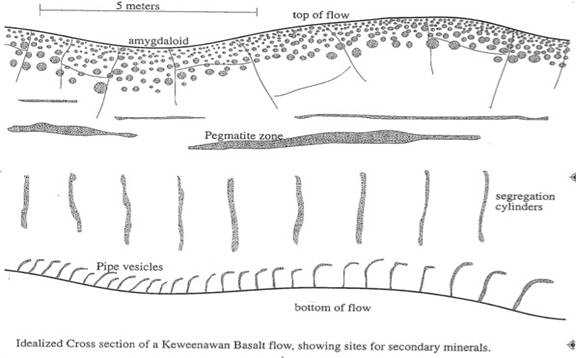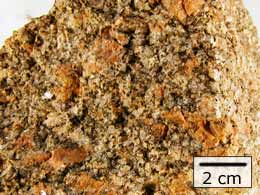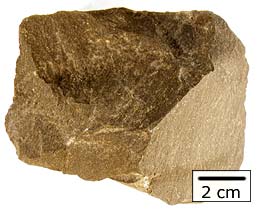Dolerite Layers in a Lava Flow
An excellent and easily accessible example of Dolerite can be seen in a large basalt boulder within the city limits of Houghton, Michigan.
Image 1. The Houghton Waterworks sign near the glacial erratic boulder. By F.Ryan
Coordinates: 47⁰ 7.026’N, 88⁰ 35.467’W
Cache Description
How do geologic processes form different features in rock of essentially the same material?
An excellent and easily accessible example of Dolerite can be easily seen in a large basalt boulder within the city limits of Houghton, Michigan. This boulder is a large glacial boulder deposited in outwash, not an outcrop (formed underground rather than on the surface). It probably is local in origin as it resembles the lava flows of the Portage Lake Volcanics, which make up much of the Keweenaw.
Dolerite is a medium grain, igneous (volcanic), mafic rock (rich in magnesium and iron but poor in silica) differing from the host rock by its color and texture. The grain size is the main distinguishing feature in many dolerites and this example shows a greater vesicularity (cavities left by air or gas bubbles) than the rest of the lava. Lava flow which reaches the surface cools rapidly forming smaller mineral grains. Magma in a sill or large flow does not reach the surface and cools slowly creating larger grains. The relatively small volume of dolerite forms underground in both flows and sills. Within large lava flows dolerites that form represent the last parts of the lava that are fluid, so they cool more slowly than the rest of the flow and are marked by larger crystals. They also have vesicular bubbles.

Image 2. The medium grain dolerite layer within the finer grain basalt. By F.Ryan
As you walk around the boulder you will see several examples of dolerite layers (see image 2). Since the boulder is not an outcrop, but glacial in origin, you should not expect the orientation of the formation to have any relation to what you see.
In both lavas and sills dolerites (sometimes called pegmatitic layers- see image 3) are most often horizontal, and form near the middle of the flow, where the effects of heat loss by the flow to the ground below and the atmosphere above are less immediate. There may be multiple layers of dolerite, reflecting separation of magma from solidifying rock.

To recieve credit for your EarthCache visit please email me the answers to the following logging questions:
1. How many dolerite layers are found in this boulder? Explain how you can tell.
2. The dolerite you are looking at most likely formed horizontally. Can you tell which direction was up when it formed? Explain your reasoning.
______________________________________________________________________________
Earth Science Vocabulary
Coarse and medium grained igneous rocks have individual grains (crystals) that are visible to the naked eye. Grains can range from millimeters to centimeters in diameter. The grains form an interlocking network.

Image 4. A rock with coarse-grained texture which had cooled relatively slowly.
Photo by: Matthew Nyman, TERC. Retrieved from:http://www.classzone.com/books/earth_science/terc/content/investigations/es0603/es0603page03.cfm?chapter_no=investigation
Fine-grained igneous rocks have small grains, less than a millimeter across, that are invisible to the naked eye. Hand samples of fine-grained rocks often appear homogeneous—they look the same throughout the rock. Hand lenses, magnifying glasses, or microscopes can reveal the small crystals in these rocks.

Image 5. A rock with fine grained texture which had cooled relatively quickly.
Photo by: Matthew Nyman, TERC. Retrieved from:http://www.classzone.com/books/earth_science/terc/content/investigations/es0603/es0603page03.cfm?chapter_no=investigation
______________________________________________________________________________
Big Idea 4.6: Earth materials take many different forms as they cycle through the geosphere,
Dolerite is an example of the same volcanic material as the basalt host rock which you can
see has formed a very different structure.
Misconception: A common misconception is that all rocks are the same.
As you can see at this site all rocks are definitely not the same even if made from the same
material.
______________________________________________________________________________
The owner of this cache is a participant in the Michigan Teaching Excellence Program (MITEP) through Michigan Technological University, which teams with science teachers to improve science teaching and learning.
______________________________________________________________________________
References:
http://www.google.com/search/dolerite (retrieved 6/5/2012)
www.lexic,us/definitionsof/dolerite (retrieved 6/5/2012)
Nyman, M (Photographer). Retrieved August 5, 2012, from: http://www.classzone.com/books/earth_science/terc/content/investigations/es0603/es0603page03.cfm?chapter_no=investigation
Rose, W. (2012). Anatomy of a Lava Flow (Image). Retrieved August, 2012 from:http://www.geo.mtu.edu/~raman/SilverI/MiTEP_ESI-1/LavaFlowTops.html
Schaetzl, Randall J., Darden, Joe T. and Brandt, Danita S, (2009)
Michigan Geography and Geology. New York: Custom Print.